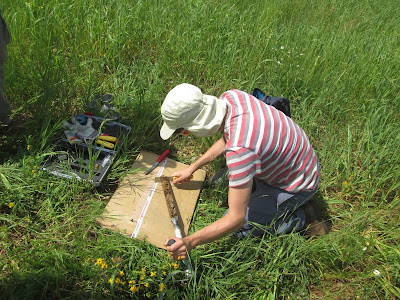Fieldwork activities: A great opportunity to expose young scientists and engineers to novel technologies
Between 29 June and 7 July, three environmental monitoring stations have been installed in an organic farm approximately 15 km east of Swindon. The stations are part of the AMUSED project, funded by NERC and lead by me, Rafael Rosolem (Lecturer in Civil Engineering), with the ultimate goal being to identify key dominant processes that control changes in soil moisture and land-atmosphere interactions in the UK.
Each station is equipped with standard meteorological sensor as well as new technology for measuring soil moisture at spatial scales of approximately 600m diameter through cosmic-ray neutron interactions at approximately. The AMUSED network covers an area of approximately 1.7 square kilometers and will provide soil moisture estimates for hyper-resolution hydrometeorological modeling around the farm taking into account spatial scale heterogeneities not seen by satellite remote sensing products. The three sites are above chalk landscape and will improve our understanding of soil moisture and evaporation dynamics in such regions across a range of spatial scales.
An important aspect recognized in the AMUSED project is to expose young engineers and scientists to the novel cosmic-ray sensor technology. Our fieldwork was organized so that a small group of scientists and engineers carried out fieldwork and laboratory activities while learning more about environmental sensors.
The small group consisted of a post-doctoral researcher (Shams Rahman), a Civil Engineering PhD student (Joost Iwema), and a Civil Engineering undergraduate student (Juliana Koltermann da Silva) from the Universidade Federal do Rio Grande do Sul in Brazil. Shams Rahman interests include understanding groundwater-atmosphere coupling through numerical models. He is currently working under the AMUSED project. Joost Iwema is a second year PhD candidate in the Department of Civil Engineering. His background is in Soil Sciences, and he has been directly working with cosmic-ray sensors. Juliana Koltermann da Silva is a Brazilian Sciences Without Borders undergraduate student with interest in Geotechnics.
While in the field, the group had a chance to interact directly with cosmic-ray sensor developer, Darin Desilets, from Hydroinnova, asking questions and learning more about this new technology. Fieldwork activities were also supported by the Faculty of Engineering and the University of Bristol International Office.
-------------------------------
This blog is written by Cabot Institute member Rafael Rosolem (Lecturer in Civil Engineering).
Each station is equipped with standard meteorological sensor as well as new technology for measuring soil moisture at spatial scales of approximately 600m diameter through cosmic-ray neutron interactions at approximately. The AMUSED network covers an area of approximately 1.7 square kilometers and will provide soil moisture estimates for hyper-resolution hydrometeorological modeling around the farm taking into account spatial scale heterogeneities not seen by satellite remote sensing products. The three sites are above chalk landscape and will improve our understanding of soil moisture and evaporation dynamics in such regions across a range of spatial scales.
 |
| Novel cosmic-ray sensor network will help estimate soil moisture at hyper-resolution while accounting for differences in land cover and soil characteristics. Source: Rafael Rosolem |
The small group consisted of a post-doctoral researcher (Shams Rahman), a Civil Engineering PhD student (Joost Iwema), and a Civil Engineering undergraduate student (Juliana Koltermann da Silva) from the Universidade Federal do Rio Grande do Sul in Brazil. Shams Rahman interests include understanding groundwater-atmosphere coupling through numerical models. He is currently working under the AMUSED project. Joost Iwema is a second year PhD candidate in the Department of Civil Engineering. His background is in Soil Sciences, and he has been directly working with cosmic-ray sensors. Juliana Koltermann da Silva is a Brazilian Sciences Without Borders undergraduate student with interest in Geotechnics.
While in the field, the group had a chance to interact directly with cosmic-ray sensor developer, Darin Desilets, from Hydroinnova, asking questions and learning more about this new technology. Fieldwork activities were also supported by the Faculty of Engineering and the University of Bristol International Office.
 |
| Woodland site: Left to right: Juliana (undergraduate student), Joost (PhD candidate), Shams (Post-Doctoral Research Assistant), and Rafael (Lecturer in Civil Engineering). Source: Rafael Rosolem |
-------------------------------
This blog is written by Cabot Institute member Rafael Rosolem (Lecturer in Civil Engineering).
 |
| Rafael Rosolem |


